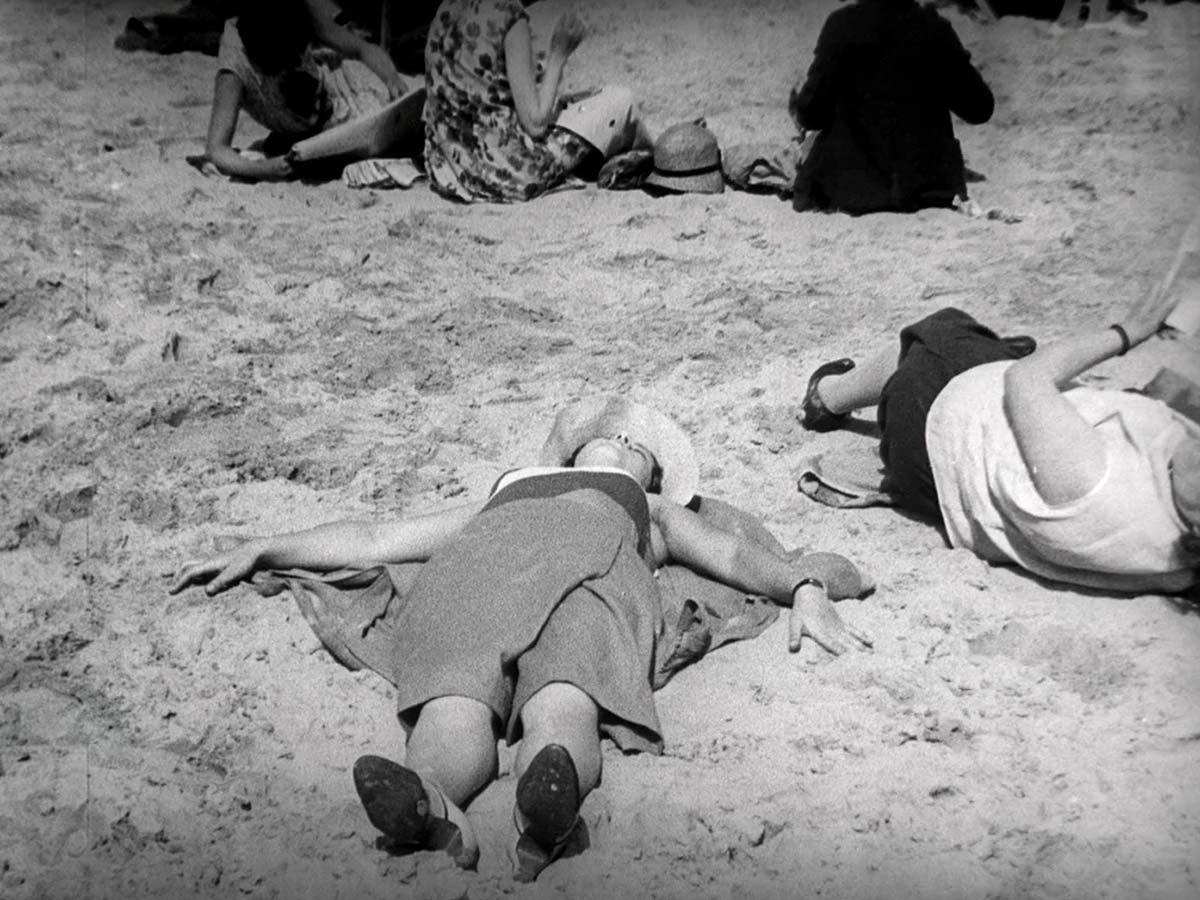
Trains de plaisir
The beach and its sunbathers. A series of sketches and portraits, small moments that culminate in a wry, loving portrait of a Sunday at the beach.
“Que d’eau! Que d’eau!” Water and nothing but water, that is what Jean Vigo witnessed watching some of Henri Storck’s Ostend films at the second Congrès International du Cinéma Indépendant, from the 27th of November until the 1st of December at Palais des Beaux-arts in Brussels. Although the exclamation may connote irritation on Vigo’s part, this was not the case. After all, Vigo himself traveled to the Belgian capital to present À propos de Nice (1930), a social-satirical portrait of the Mediterranean port town in the South of France. The film obviously did not lack water. Storck, however, in his first films—amongst which Images d’Ostende (1929-1930) and Trains de plaisir (1930)—paid special attention to the crashing waves and the interplay of sea and shore. The two filmmakers bonded in between the Brussels’ screenings, as Storck would later travel to Nice to assist Vigo on the set of Zéro de conduite (1933).
Earlier in 1930, Storck was entitled ‘official filmmaker of the city of Ostend’. Allowing him to—next to his sales and administrative work in his late father’s shoe shop—take to town and record gentlemen in bespoke suits, seated in beach chairs with legs extended off the ground in an attempt to keep their precious shoes from touching the water, as seen in Trains de plaisir. The twentysomething had been tasked with capturing day-to-day life in Ostend, to be screened in theater. He himself, however, negotiated room for personal work and experiment.
Some years prior, another trip to Brussels heavily impacted Storck’s filmic ambitions. On the 11th of February in 1927, he attended a screening of Moana (1923-1926), Robert Flaherty’s film depicting the fictionalized lives of inhabitants of the Polynesian island Savai’i relying on fishing for subsistence. Although the ocean waves crashing into the rocky shore have the water rising to heights unthinkable in the Belgian seascape, Flaherty’s exoticizing images must have reminded Storck of his hometown. On his train ride back to Ostend, he swore to start a film club. He also vowed to wield the camera himself: “I had no doubt that we too could make such truthful, such real, such beautiful, such humane films.” 1
The truthful nature of Moana and other of Flaherty’s works like Nanook of the North (1922), where he staged or even invented local rites, had been rebutted many times. However, the films’ impact remains the same. As a documentary filmmaker, Storck strived to be a witness of his own time; in his earlier films, this manifested itself in poetic observations of the city where he grew up, where he lived across a movie theater, and where he was introduced into artistic circles thanks to his family. His development as a filmmaker was influenced by the likes of painters James Ensor, Félix Labisse, Léon Spilliaert, and other Ostend locals.
Should we interpret the bent-over beach visitors’ behinds or the naked squatting child, as they present themselves in Trains de plaisir, as a reference to Ensors’ scatological paintings? Storck can hardly be described as provocative. Much like the long, striped unisex bathing suits he captures on film, his style, too, is modest. Vigo in À propos de Nice, with its freely whooshing camera, associative and invigorating editing, and the subjects on display, proves himself much more playful. Vigo’s approach to coastal life is explicitly surrealist: take the jump cut from dressed to naked woman, or the sudden burnt face of a man, or the attention to the chaotic nature of carnival and dance. This blatant ridiculing of the bourgeois lifestyle shows the Ensorian spirit much more present in Vigo’s work than that of the young filmmaker who joined Ensor for porto in the afternoon.
Nonetheless, the correlation between the bourgeoisie, leisure time, and the beach is clear in Storck’s work too. Hats and dressing shoes dart around children who are scared of the water, anxiously latch on to their mother’s hand, or, contrastingly, lose themselves completely in their beach and sea-inspired games. It is a light irony but a predominant harmony that exemplifies Storck’s portrayal of the carefree life at the beach. No trace of trains to be found—unlike in À propos de Nice—however, the title does suggest travel via railway to the Belgian coast. Dabbling their feet in the water, playing rough, and tumbling on the soft sand, the people depicted in his film enjoy themselves as much as Storck does while recording and rhyming his images. With the exception of one bare behind, Trains de plaisir shows a lyrical prudeness, both in the camera's handling and the overall attitude; the film feels more stable and harmonious than Vigo’s. We are left to imagine the train ride home ourselves, perhaps with grains of sand still rubbing between our toes.
- 1Cited from: Vincent Geens (2000), ‘Le temps des utopies. L’ambition cinématographique d’Henri Storck, de 1907 à 1940’, in: Cahiers d’Histoire du Temps Présent, number 7, p. 189-237.
Henri Storck's Images d'Ostende, mentioned in the text, is available to stream on Avila.
A young couple in Kyoto. A girl makes up an excuse to run away from her monotonous life. She would like to say something to her boyfriend. Can she still return now that night is falling?



